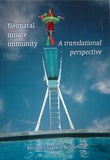Neonatal innate immunity
A translational perspective

Belderbos, Mirjam
- Promoter:
- Prof.dr. J.L.L. (Jan) Kimpen & prof.dr. L. (Linde) Meyaard
- Co-promoter:
- Dr. L.J. (Louis) Bont
- Research group:
- Bont , Inhibitory receptor lab
- Date:
- February 7, 2012
- Time:
- 14:30 h
Summary
Human newborns are highly susceptible to infections, which appears to be due to immaturity of the neonatal innate immune system. At birth, neonatal innate immune responses are characterized by decreased Th1-polarizing responses, whereas generation of Th2-polarizing and regulatory responses is increased. This bias is thought to prevent potentially harmful alloimmune reactions towards maternal antigens in utero, and to facilitate microbial colonization after birth. However, impaired generation of pro-inflammatory responses renders the neonate highly susceptible to infections. In addition, dysregulated innate immune responses at birth may play an important role in the pathogenesis of atopy and asthma. Although impairments in neonatal innate immune responses at birth have been well characterized, little is known on the early postnatal development of the human innate immune system and its consequences for health and disease. This thesis aims to characterize the ontogeny of the neonatal immune system during the first month of life and its consequences for subsequent infections and atopy. We demonstrate that the neonatal innate immune system undergoes drastic changes during the first month of life, transitioning from a Th2-predominant state to more Th1-biased responses. This suggests that the first month of life provides a window of opportunity for immune modulatory strategies aimed at preventing infections and/or atopy. We identified breastfeeding as the most important environmental determinant of neonatal innate immune responses at the age of one month. In addition, in vitro studies demonstrate that distinct soluble factors in plasma account for decreased neonatal TLR4-mediated production of IL-12p70 and increased production of IL-10. We hypothesized that delayed postnatal TLR maturation, resulting in impaired Th1- polarizing responses at the age of one month, predisposes to microbial infections and to atopy. In a prospective birth cohort study, neonates with subsequent atopic dermatitis had twofold decreased TLR4-mediated IL-10 production at the age of one month compared to those without atopic dermatitis. No differences were found between neonates with and without subsequent respiratory syncytial virus (RSV) bronchiolitis. Vitamin D is an essential nutrient and hormone with extensive immune modulatory functions that might protect against severe RSV infection. This thesis demonstrates that vitamin D deficiency is highly prevalent among healthy neonates. Moreover, vitamin D deficiency at birth was associated with six fold increased risk of RSV bronchiolitis in the first year of life. Together, the studies in this thesis indicate that early life immune development provides a unique opportunity for interventions aimed at preventing atopy and infectious diseases. Suggested strategies include promotion of breast feeding, intensified vitamin D supplementation during pregnancy, and plasma-directed therapies. Future randomized clinical trials are needed to establish the feasibility of early life immune modulation in the prevention of subsequent disease.